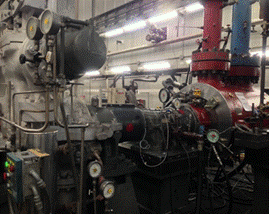Performance and mechanical running tests of centrifugal compressors - II
SEQUENCE OF SHOP TESTS

Compressor performance test can be conducted either before, or after the mechanical running test.
If a compressor was first subjected to mechanical running test but failed the performance test, the time, resources, and efforts expended in arranging the mechanical running test would be deemed wasted. From this viewpoint, some users prefer to run performance test first, followed by mechanical running test. If a spare rotor was purchased, the performance tested rotor, in this situation, will likely not be installed in the casing during final assembly in shop.
It is a common practice that compressor manufacturers carry out factory internal test prior to customer (or user) witnessed test. Therefore, many users specify mechanical running test of spare rotor first, followed by mechanical running test and performance test of the job or main rotor. In this arrangement, the performance tested rotor is usually left in the compressor casing at delivery from the shop. The order of tests shown below is only typical and can vary, depending on the scope and mutual agreement between the user and the compressor manufacturer. The requirements of mechanical running test and performance test are included in API Standard 617.
1. Mechanical running test under vacuum, with spare rotor.
2.Vary lube oil supply pressure and temperature in the second-half (after two hours) of mechanical running test with spare rotor.
3.Spare rotor change with the main rotor. During this activity, visually inspect bearings, seals and internal parts.
4.Mechanical running test under vacuum, with main rotor.
5.Vary lube oil supply pressure and temperature in the second half (after two hours) of mechanical running test with main rotor.
6.Shop verification of unbalance response test on main rotor at the end of four-hour mechanical running test.
7.Sound pressure level check during mechanical running test on main rotor.
8.ASME PTC-10 performance test with main rotor.
9.Bearings strip-down and visual check.
10.Assembled compressor gas leakage test.
FULL-SPEED, FULL-LOAD TEST

Complete Unit Test is included in API Standard 617 under the section ‘Optional Tests’. Frequently, it is called as string test. Many users stipulate full-speed, full-load mechanical running test for compressors in offshore installations, large liquefied natural gas (LNG), re-injection, and ethylene plants. This is partly due to the fact that output of these facilities has been increasing over the years, thus requiring larger frames/bigger casings. Some of the important considerations for specifying a full-speed, full-load test for compressors are presented in this section.
·Largest frame sizes for the compressor, (gear if furnished), driver, and auxiliary systems being used in a given application. Note: users should check if these frames are installed and operating successfully under analogous conditions at other locations.
·Compressor with multiple operating conditions that have direct impact on the plant's output.
·Shorter plant commissioning schedule resulting in far lesser time to adjust the performance of critical machines in the field. In such situation, users may want to pay more money upfront for complete unit test than having to spend much more in rectifications at site, if something were to go wrong.
·Known rotordynamic issues or concerns arising from stability analysis of the compressor.
·Compressor with multiple side loads.
·Compressor fitted with honeycomb seals, shunt holes, or swirl brakes. These features may require more exhaustive testing than conventional performance test and mechanical running test.
·Ability of the test shop to conduct complete unit test.
·Logistics of transporting gear and auxiliary equipment to the test shop. Does the project schedule allow for additional time duration for transportation?
If a complete unit test is specified for compressors installed in identical, multiple production trains, it may be carried out on the compressor(s) in only one train.
TEST PROCEDURE DOCUMENTATION
The test Procedure should be detailed enough to serve as the single source of reference when conducting performance and mechanical running tests. Ideally, it should include the following information.
·Test Sequence and overall schedule
·Type, location, quantity, and accuracy of instrumentation used for test. Their current calibration records should be available.
·Mechanical running test program including graphical presentation of test steps in speed versus time form.
·Schematic of mechanical running test arrangement. An example is shown in Figure 1.
·Mechanical running test measurements and sampling rate. The following list is typical and will vary, depending on the specific application.
1.Lube oil pressure at each supply point, psig (kpag)
2.Lube oil supply temperature, deg F (deg C)
3.Lube oil flow at each bearing, gpm (lt/min)
4.Lube oil drain temperature at each return point, deg F (deg C)
5.Bearing metal temperature, each bearing, deg F (deg C)
6.Speed, rpm
7.Inlet vacuum, psia (kpaa)
8.Inlet temperature, deg F (deg C)
9.Filtered and unfiltered shaft vibrations, mils peak-to-peak (microns peak-to-peak)
10.Axil displacement of rotor, mils (microns)
11.Buffer gas supply pressure to dry gas seals, psig (kpag)
12.Sweep of frequencies at maximum continuous speed and recording of vibration amplitude versus frequency range
13.Unfiltered and filtered vibration amplitude and phase angle versus speed plots during coastdown.
14.Determination of first lateral critical speed
15.Slow roll run-out
·Mechanical running test acceptance criteria.
·Performance test procedure.
·Schematic of performance test arrangement.
·Tabulation of test and specified (or design) conditions.
·Adjustment of test conditions to contract or design conditions.